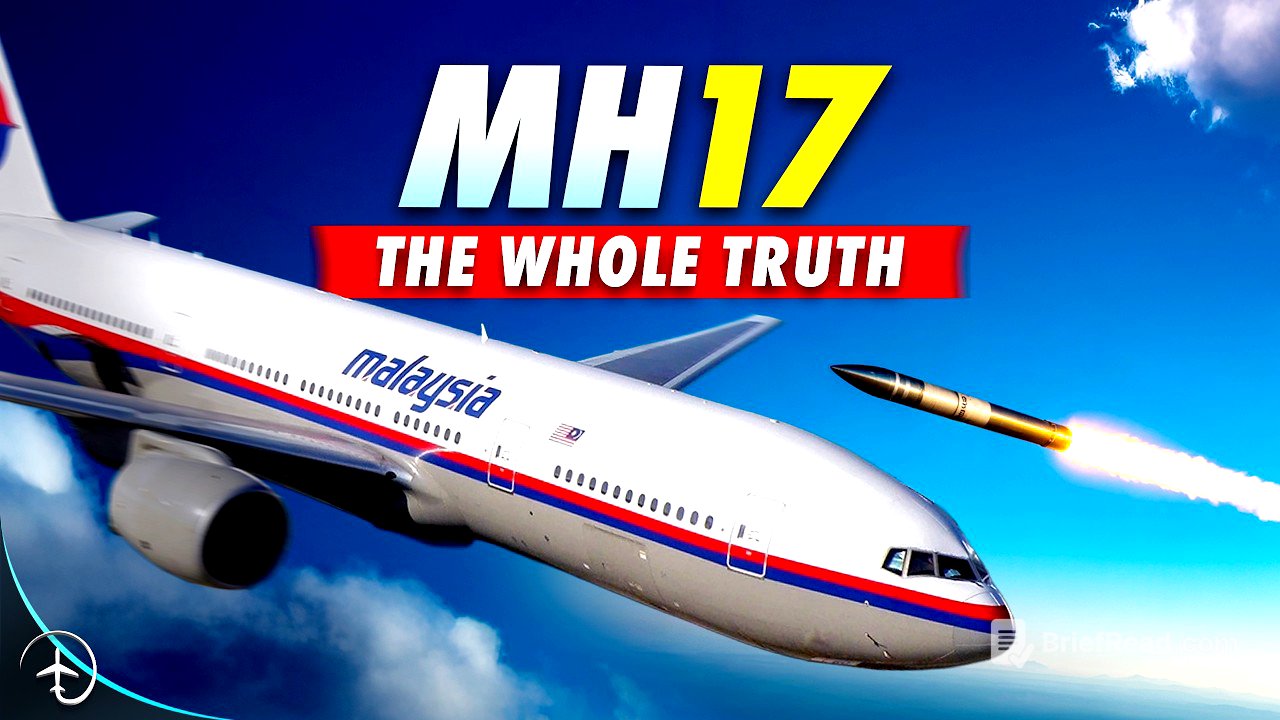TLDR;
This video investigates the tragic downing of Malaysian Airlines flight MH17 over eastern Ukraine on July 17, 2014. It explores the complex circumstances surrounding the event, including the war zone below, the presence of advanced weaponry, and the failures in command and control that led to the disaster. The video also examines the investigation process, the identification of the weapon used, and the assignment of responsibility.
- The flight MH17 was flying over a war zone in eastern Ukraine where pro-Russian separatists were in conflict with Ukrainian forces.
- The aircraft was shot down by a Buk surface-to-air missile system.
- The investigation concluded that the missile was launched from separatist-held territory and that Russia was responsible for the missile.
Intro [0:00]
On July 17, 2014, Malaysian Airlines flight MH17, a Boeing 777-200ER, was en route from Amsterdam to Kuala Lumpur, cruising at 33,000 feet over eastern Ukraine, a region embroiled in a conflict between pro-Russian separatists and Ukrainian forces. Despite the ongoing war below, the flight was considered routine, with the pilots unaware of the imminent danger. Unbeknownst to the passengers and crew, a Buk surface-to-air missile launcher was scanning the skies, poised to turn the flight into a tragic event in aviation history. The video aims to explain the circumstances, including the war, misinformation, advanced weaponry, and failures in command and control that led to the downing of MH17.
Why Was MH17 Flying Over a Warzone? [8:27]
In early 2014, Ukraine was in political and military turmoil, starting with the Euromaiden protests against government corruption, which led to the ousting of pro-Russian President Victor Yanukovich. Russia then annexed Crimea and supported pro-Russian separatists in eastern Ukraine, providing them with money, weapons, and personnel, including advanced weaponry like the Buk missile system. On July 17, 2014, MH17 was one of several civilian airliners flying through airspace considered safe at 33,000 feet. The flight, operated by a Boeing 777-200ER, carried 298 people, including 283 passengers and 15 crew members, from various countries. The flight crew consisted of four experienced Malaysian pilots. Despite the ongoing conflict below, a sense of normalcy prevailed at cruising altitude, but the elements of a tragedy were present: a war on the ground, crowded skies, and advanced weaponry in the hands of separatists.
Airlines balance safety, cost, and efficiency when choosing routes. The route over eastern Ukraine, specifically along the L980 airway, was popular because it was a direct and efficient path between Europe and Southeast Asia. The Ukrainian government had issued a NOTAM restricting airspace below 32,000 ft due to conventional ground-based weapons, but above that altitude, the airspace was considered safe by international consensus. Aviation regulators, air traffic control organizations, and safety authorities believed that commercial flights at cruising altitude were out of reach of known weapons. MH17 was cruising at 33,000 ft, just above the restricted zone, and the crew's request to climb to 34,000 ft was denied due to other traffic. Many carriers, including Lufthansa, Air France, and KLM, used this route, following international guidelines that considered it safe. On July 16, the day before the MH17 disaster, 160 flights had crossed through the same airspace.
What Hit MH17? [14:22]
MH17 was following its flight plan with no indication of danger, but a more powerful weapon system than expected was present: the Buk surface-to-air missile system. The conflict in Ukraine involved extensive support from Russia to the separatists, including funding, weapons, and military personnel. Ukraine's military was using its air force to support ground troops, making those aircraft targets for the separatists. Initially, the separatists used smaller, shoulder-fired anti-aircraft weapons (MANPADS) that could only reach low-flying aircraft. As the conflict escalated, the Ukrainian Air Force flew at higher altitudes, beyond the reach of MANPADS, so the separatists needed a more capable system: the Buk missile system.
The Buk, known as the "Gadfly" by NATO, is a medium-range, radar-guided surface-to-air missile system developed by the Soviet Union. It is a self-contained, mobile system with a radar unit, command vehicle, and launch vehicles mounted on armored vehicles. The missiles can reach targets at altitudes up to 70,000 ft, far beyond the cruising altitude of commercial airliners, and are designed to engage fast-moving targets like fighter jets. The Buk system used by the separatists was a modernized version, the Buk M1, still in use by the Russian military. According to the Dutch Safety Board, this Buk system came directly from Russia, not from the Ukrainian military. Witnesses saw a convoy of military vehicles, including a Buk launcher, crossing the Russian-Ukrainian border before the disaster. Investigative journalists tracked the Buk system's route across eastern Ukraine using open-source intelligence, identifying it as part of Russia's 53rd anti-aircraft missile brigade based in Kursk.
Russia provided the Buk system to counter the Ukrainian air force and create an air defense bubble over separatist positions. However, such a powerful weapon requires proper training, command, and control procedures. In this case, the Buk was operated by a mixed crew of Russian and separatist fighters who were not properly trained or supervised. On July 17, the Buk was positioned near the town of Schnitzn, ready to engage any aircraft deemed hostile, without a clear command structure.
How was MH17 Shot Down? [19:05]
MH17 was flying at flight level 330 over Ukrainian airspace, and air traffic control had approved its routing. As the flight approached the Nepov flight information region, Ukrainian air traffic control asked the crew if they were ready to climb to flight level 350. Another aircraft, Singapore Airlines flight 351, was nearby at the same altitude, so MH17 requested to remain at flight level 330, which was approved. Later, the crew requested a minor deviation to avoid weather, which was also approved. They then asked to climb to flight level 340, but this request was denied because that flight level was in use.
Air traffic control noticed that the flight had deviated slightly off course and asked them to return to the track, which they agreed to do. Ukrainian controllers contacted their Russian counterparts to request permission to hand over MH17 as it neared Russian-controlled airspace, and permission was granted. However, attempts to contact MH17 with the transfer instructions were unsuccessful. Russian controllers then reported that the target was gone. Military radars detected several small aircraft descending, which turned out to be debris from MH17. There were no other aircraft, civilian or military, within 30 to 60 km of the site. Local residents were the first to arrive at the crash site, initially assuming it was a military aircraft due to the war zone, but they soon realized it was a civilian airliner.
MH17 Investigation [23:59]
An investigation was launched, led by the Dutch Safety Board (DSB), with a separate criminal inquiry by the joint investigation team (GIT). Russia offered to help but was excluded from the GIT due to concerns about impartiality. The crash site was difficult to access due to pro-Russian separatists controlling the territory, which limited the movement of international observers. There were reports of looting and tampering. The United Nations Security Council tried to pass a resolution demanding full access to the crash site, but it was vetoed by Russia.
Once access was secured, Ukrainian emergency services began collecting debris, which was transported to the Gil Rhen Air Force Base in the Netherlands. Investigators reconstructed the aircraft, photographing and cataloging each piece. The DSB evaluated all possible causes, ruling out technical malfunction because the flight data recorder showed no abnormalities. Sabotage or a bomb on board were ruled out due to the lack of explosive residue and the inconsistent damage pattern. Even improbable causes like a meteorite strike were considered but dismissed due to the lack of evidence.
The reconstruction revealed damage consistent with high-energy fragments impacting at extreme velocity. Strings were used to trace the blast origin to a single point just ahead and to the left of the cockpit. Investigators recovered bow tie and cube-shaped shrapnel with a distinct metal composition, embedded in the cockpit walls and fuselage. Air-to-air cannon fire and missiles were ruled out based on the damage patterns and radar data. Fragments of the missile were found and identified as belonging to the 9M38M1 missile, used in the Buk system. The warhead type was confirmed as a 9M314 Mike, which produces the bow tie-shaped shrapnel found in the aircraft. The joint investigation team traced the missile launcher's path from Russia into Ukraine, identifying it as belonging to Russia's 53rd anti-aircraft missile brigade. Civilian videos and intercepted communications placed the Buk system in separatist-held territory.
Who Was Responsible for MH17? [31:07]
Russian state media launched contradictory narratives after the shootdown, claiming Ukrainian fighter jets or a Ukrainian Buk system were responsible. Russia's Ministry of Defense released satellite images that they claimed showed Ukrainian launchers nearby, but analysts determined that these images had been digitally altered. Despite these efforts of misinformation, the evidence pointed to the conclusion that MH17 was destroyed by a 9M38M1 missile launched from a Buk system operated by Russian-backed separatists in eastern Ukraine. The Dutch Safety Board's systematic approach cut through propaganda and conspiracy theories to reveal what happened.
At around 16:10 local time, the pilots of MH17 were monitoring their instruments as normal. On the ground near Schnitznney, a Buk missile system was on high alert to provide air defense against Ukrainian military aircraft. The system was designed for a war zone, meant to track and destroy hostile aircraft. However, the situation in eastern Ukraine was not precise. A radar contact appeared on the Buk system's targeting screen, but the radar did not identify the aircraft type or that it was a civilian airliner.
The Buk crew was supposed to verify the target's identity using identification friend or foe (IFF) signals, confirm with their higher command, and check flight schedules. MH17's transponder was active, broadcasting its identity, and commercial flight schedules were publicly available. However, these procedures were not followed. There was no clear command structure, and the Buk crew was operating semi-independently, making their own decisions. No one checked for IFF signals or flight schedules. In that confusion, a civilian airliner became a target. The decision was made, and the Buk crew launched the missile.
What Was The Result of MH17? [38:06]
The missile accelerated to supersonic speed and approached MH17. The crew would have had little time to react. The missile, equipped with a proximity fuse, detonated just ahead and to the left of the cockpit, sending shrapnel into the aircraft. Over 800 high-energy objects tore through the fuselage, destroying the nose and forward part of the aircraft. The pilots and a purser were killed, and business class passengers were likely also killed. The blast shattered the forward section of the aircraft, causing structural failures. The wings and rear fuselage broke away, and the flight data recorder and cockpit voice recorder cut off.
The decompression would have been instantaneous, and the passengers would have become unconscious within seconds. Investigators do not believe that anyone suffered or was aware of what was happening. The main fuselage continued its downward spiral, scattering pieces over several kilometers. The Dutch Safety Board concluded that the aircraft had been downed by a Buk missile launched from separatist territory. The joint investigation team charged four individuals with responsibility for the attack. In May 2025, the UN's International Civil Aviation Organization (ICAO) declared that Russia was responsible for the missile that brought down MH17.
The MH17 disaster is a reminder that even internationally approved air corridors are not always safe. The airspace over eastern Ukraine had not been closed because no one had demonstrated the capability or willingness to target civilian aircraft at 33,000 ft. In the years since the disaster, international aviation authorities have changed how they evaluate conflict zones. Airlines are more cautious when routing flights through or near areas of active conflict, and some have established internal risk teams and work with intelligence agencies. The full-scale Russian invasion of Ukraine in 2022 closed the airspace over the country permanently. The Dutch Safety Board and the Joint Investigation Team built their case based on facts and evidence, ruling out every other possible cause.









